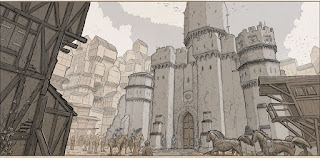For my final piece I made another render of my model in Maya using Mental Ray in a perspective I haven't really represented in most of my work for this project.
I made the building the focal point of the render and moved the saved JPG file to Photoshop.
Within Photoshop I didn't just take the image and make it Black and White, I felt that would be cheating. Instead I used my experience making the thumbnails for this project to use the different percentage swatches of the grey scale available in Photoshop to paint over the image using Normal layers, eyeing up the shades of grey I saw and remembering knowledge from my 1st year at university, mainly that all shadows are at 50% on the grey scale so I made the main shadow of the building 50%.
I also used a texture brush to add detail to my right hand side background. This is where the waterfall cliff face followed on.
I mainly made use of the gradient tool and the basic hard edge brush to create the complete grey scale version of the piece.
Upon completing the grey scale version I two things left to decided on; first was the overall tone of the image when I began to apply colour, second was how I was going to make the left hand side background interesting.
With some advice I added the idea of a brick path along the bridge leading to the front door. At first I figured I would just extend the bridge/path to the edge of the canvas but then I decided that I would curve the path around off canvas, as if the path from the bottom left corner of the canvas led up from a hill and connected/curved into the path leading to the front door of the mill.
As I began to apply colour to the scene I began with the ground. I already knew that I wanted there to be healthy overgrown grass at the base of the mill, thanks to its proximity to the waterfall. As I added grass to the ground I enjoyed the idea that the grass is overgrown not just because of its proximity to the waterfall but also because the mill has long been abandoned.
I loved the idea that the mill has been sat here for some time but the water still flows through the mill wheels in the bridge, turning the cogs inside and raising the trip-hammers inside. I liked the character it gave this building as the hammers would continue to rise and crash down without reason.
To emphasise this I decided to paint the mill as though it were rotting somewhat and that it had grown mouldy due to the proximity to the waterfall without human care.
To add to the idea of the hammers still working I added birds flying off into the distance, as though they had just been disturbed by the crash of one of the hammers falling once again.
I then came back to the piece after some time and gave it a look over. I really like how this has turned out and I had a thought to improve it, as the water from the waterfall would hydrate the area frequently I decided to paint moss and leaves and vines growing on the mill itself to add some more character and make the narrative of the scene easier to spot.
I definitely think this has been one of my best 2D artistic creations, especially considering I am not to confident with colour yet, however I am finding that painting in grey scale has helped improve my eye for tone immensely and has improved the overall quality of my final piece when I came to paint the scene.
For improvement I would go over the mill design once more and I would change a couple of things. Firstly I would make the design symmetrical, right now the design has the mill pressed against the waterfall cliff face which I thinks works contextually; however human design is typically symmetrical as standard.
Secondly I would adjust the overall structure so that it was so neat, modern era architecture is mostly neat, however contextually this mill has been built around the 14th century and I think it would add character to the design had the walls been a little more curved. I had included the curved walls somewhat but they are hard to see as they are only noticeable at the base in the shadows of the wooden supports.
Thirdly I would overhaul the design of the irrigation system of the mill, I think it would function but it's not terribly well conceived.
A last minute addition I made to my final piece was that of a palette swap on the roofs of the mill, I feel this better implies the thatched materials of the roofs with colours swinging towards yellows, browns and greens. I also feel the change helps set the narrative of this dilapidated mill with the thatched roofs growing mould in the moist environment of the waterfall.
A last minute addition I made to my final piece was that of a palette swap on the roofs of the mill, I feel this better implies the thatched materials of the roofs with colours swinging towards yellows, browns and greens. I also feel the change helps set the narrative of this dilapidated mill with the thatched roofs growing mould in the moist environment of the waterfall.














































